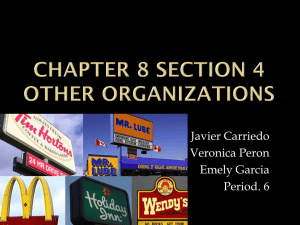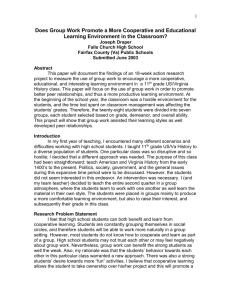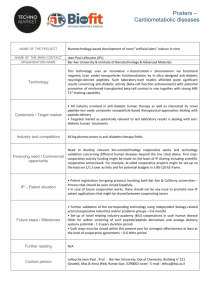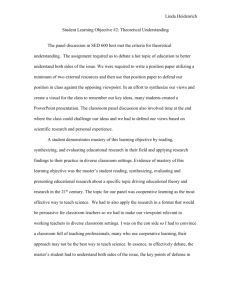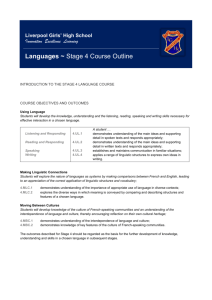School-wide Pre-observation Sample 3
advertisement
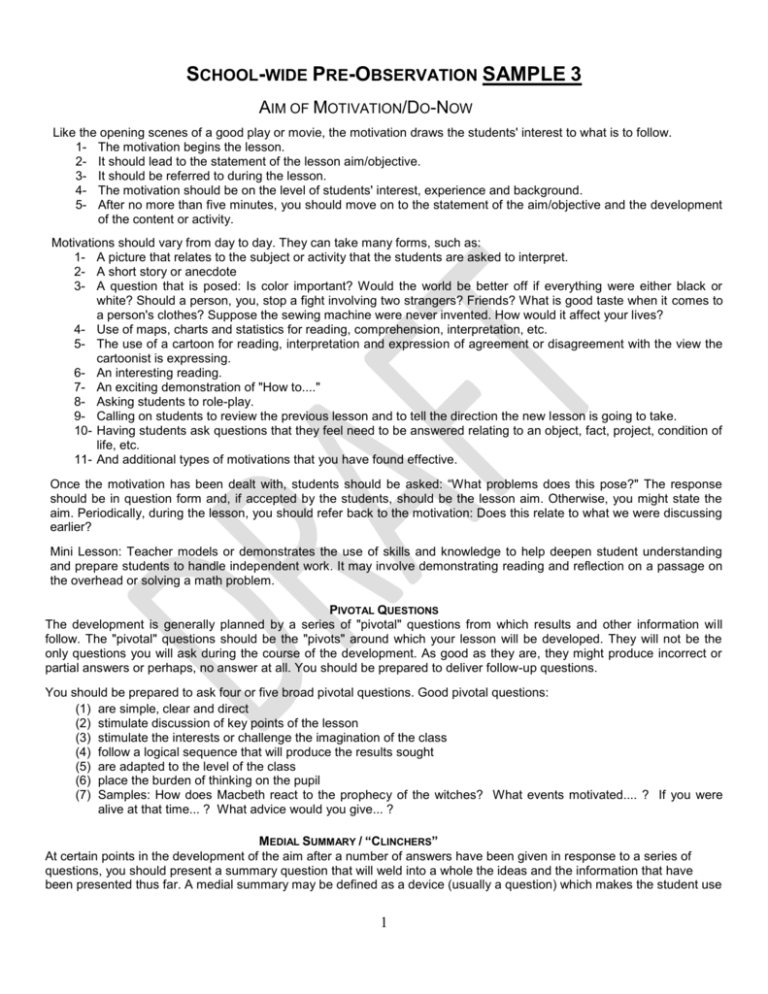
SCHOOL-WIDE PRE-OBSERVATION SAMPLE 3 AIM OF MOTIVATION/DO-NOW Like the opening scenes of a good play or movie, the motivation draws the students' interest to what is to follow. 1- The motivation begins the lesson. 2- It should lead to the statement of the lesson aim/objective. 3- It should be referred to during the lesson. 4- The motivation should be on the level of students' interest, experience and background. 5- After no more than five minutes, you should move on to the statement of the aim/objective and the development of the content or activity. Motivations should vary from day to day. They can take many forms, such as: 1- A picture that relates to the subject or activity that the students are asked to interpret. 2- A short story or anecdote 3- A question that is posed: Is color important? Would the world be better off if everything were either black or white? Should a person, you, stop a fight involving two strangers? Friends? What is good taste when it comes to a person's clothes? Suppose the sewing machine were never invented. How would it affect your lives? 4- Use of maps, charts and statistics for reading, comprehension, interpretation, etc. 5- The use of a cartoon for reading, interpretation and expression of agreement or disagreement with the view the cartoonist is expressing. 6- An interesting reading. 7- An exciting demonstration of "How to...." 8- Asking students to role-play. 9- Calling on students to review the previous lesson and to tell the direction the new lesson is going to take. 10- Having students ask questions that they feel need to be answered relating to an object, fact, project, condition of life, etc. 11- And additional types of motivations that you have found effective. Once the motivation has been dealt with, students should be asked: “What problems does this pose?" The response should be in question form and, if accepted by the students, should be the lesson aim. Otherwise, you might state the aim. Periodically, during the lesson, you should refer back to the motivation: Does this relate to what we were discussing earlier? Mini Lesson: Teacher models or demonstrates the use of skills and knowledge to help deepen student understanding and prepare students to handle independent work. It may involve demonstrating reading and reflection on a passage on the overhead or solving a math problem. PIVOTAL QUESTIONS The development is generally planned by a series of "pivotal" questions from which results and other information will follow. The "pivotal" questions should be the "pivots" around which your lesson will be developed. They will not be the only questions you will ask during the course of the development. As good as they are, they might produce incorrect or partial answers or perhaps, no answer at all. You should be prepared to deliver follow-up questions. You should be prepared to ask four or five broad pivotal questions. Good pivotal questions: (1) are simple, clear and direct (2) stimulate discussion of key points of the lesson (3) stimulate the interests or challenge the imagination of the class (4) follow a logical sequence that will produce the results sought (5) are adapted to the level of the class (6) place the burden of thinking on the pupil (7) Samples: How does Macbeth react to the prophecy of the witches? What events motivated.... ? If you were alive at that time... ? What advice would you give... ? MEDIAL SUMMARY / “CLINCHERS” At certain points in the development of the aim after a number of answers have been given in response to a series of questions, you should present a summary question that will weld into a whole the ideas and the information that have been presented thus far. A medial summary may be defined as a device (usually a question) which makes the student use 1 the material just learned in a different situation to test whether or not he/she has actually grasped what has just been taught. > In light of what we have discussed, ... ? > Which one is the most important? Why? > Which of these causes... ? > If you were Romeo...? FINAL SUMMARY A final summary is asked to determine whether or not the aim has been achieved A good final summary requires the ability to use the material learned during the lesson. It should also arouse a sustained discussion. > Could ________ have been avoided? > Did ________ help or harm _______? APPLICATION An application asks students to take the new information learned and apply it to a different situation or a current problem. > On the basis of what we have learned today, what advice would you give to...? > In what ways would______life be different...? HOMEWORK Homework assignments are a critical component of any daily lesson. They can be used to reinforce the day's lesson or to prepare your students for the next day's lesson. The type of homework assignment should be determined by the: > cognitive level of the students > difficulty of the material covered It should be of at least twenty minutes duration and should ask students to think critically and write clearly. WORKSHOP MODEL The structure of the mini lesson in the workshop model includes 6 components. The first part is the connection; the teacher starts by connecting the current lesson to something previously done. Next comes the teaching point; the teacher states explicitly and repeatedly what s/he is teaching in this lesson. Next the teacher models or demonstrates what s/he wants the students to do. Next is the active engagement – all the students try out or discuss what it is they are suppose to do. The last part of the mini lesson is the link; this is where the teacher tells the students what they will do during the independent period; the students work independently while the teacher walks around and confers with individual students. After the teacher briefly shares using the students’ work as examples. COOPERATIVE LEARNING Cooperative learning is an integral part of the constructivist model of teaching and learning and is a priority at Williamsburg Prep. Cooperative learning is a successful teaching strategy in which pairs of students or small teams of students, each with different levels of ability, use a variety of learning activities to improve their understanding of a subject. Each student in a cooperative learning pair or group must be individually accountable for completing a specific part of the learning activity and sharing the results with the rest of the group. Cooperative learning promotes positive interdependence among students and subsequently helps in the creation of learning communities. Students learn to depend on each other as they ask for and receive help for one another. Research shows the cooperative learning promotes improved academic achievement, improved student attendance and behavior, increased self-confidence and motivation, and increased liking of school and classmates. Some examples of cooperative learning structures: o o o Group investigations Jigsaw activities Book clubs o o Reading Partnerships Peer editing 2 o o Peer conferencing Think/Pair/Share


